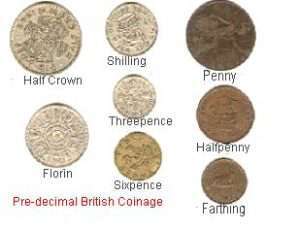You may have heard this phrase before (if you've ever listened to Hamilton.) "Quid pro quo" is still commonly used today, though it is a Latin phrase meaning "this for that" and is most common in political circles. Ironically, "Quid" is also a well-known nickname for the pound, and so the phrase has also become a play on words, when used in common speech. What does this have to do with Mill on the Floss? Why, it's money, of course!

Money does not seem to be as big of a deal to us when we look back on history. Someone can say to us "back then, they had to pay $35, which was a small fortune!" And we say, in response, "so what?" But in order to understand the Tullivers' wealth and sacrifices monetarily, and then the subsequent loss of this monetary stature, we should explain a few details of the value of money at that time.
The pound sterling is the world's oldest currency still in use and has been in continuous use since its inception. The British pound has its origins in continental Europe under the Roman era, as early as 775 AD. Its name derives from the Latin word "poundus" meaning "weight". The £ symbol comes from an ornate L in Libra. The pound sterling was equivalent to 1 pound weight of silver. This was a vast fortune in the 8th century. In 928, Athelstan, one of the first kings of England, adopted sterling as the first national currency. The Bank of England was founded in 1694, followed by the Bank of Scotland a year later. Both began to issue paper money. Silver remained the legal basis for sterling until 1816. The official gold standard was established when Germany adopted it, encouraging mass -international trade for the first time. The idea was that a nation must back its money in circulation with the equivalent in gold reserves. This rendered silver coins as a "token" issue (i.e. not containing their value in precious metal). In 1817, the sovereign was introduced, valued at 20 shillings. The average annual income circa 1800 was less than £20.

In the Victorian era, the common coinage and amounts are as follows (note: each coin is valued by how many units it would take to make a pound. Thereby, a pound is equal to one): Sovereign (Pound): 1 Five pound note: 1⁄5 Two pound note: 1⁄2 Crown: 4 Half-crown: 8 Florin: 10 Shilling: 20 Sixpence: 40 Groat: 60 Threepence: 80 Penny: 240 Halfpenny: 480 Farthing: 960 Half Farthing: 1920 Third Farthing: 2880 Quarter Farthing: 3840 In 1800, £1 would equal approximately around £100 today. Most people never saw a pound: their money came in farthings, halfpennies, pennies, and tokens. British government sources suggest that prices have risen over 61-fold since 1914, so a medieval sterling silver penny might have had purchasing power equivalent to £4.50 today, and a farthing (a quarter penny) would have the value of slightly more than today's pound (about £1.125).
Around 1800 the average weekly wage was around 6-10 shillings and many people earned far less. The British pound experienced an average inflation rate of 2.03% per year between 1800 and 2017. £100 in the year 1800 is worth roughly £7,891 in 2017, a 7791.5% increase in prices. Since the average income in this period (1800-1825) was less than £20 a year, most people went through life without ever coming into contact with banknotes.

In essence, when you hear these monetary phrases tossed around onstage, you should be aware that these are no idle sums. Think about the status that the Tullivers have at the beginning of the play, and how that is changed as the play progresses. How are their daily lives affected when they don't have the money that they once did?

